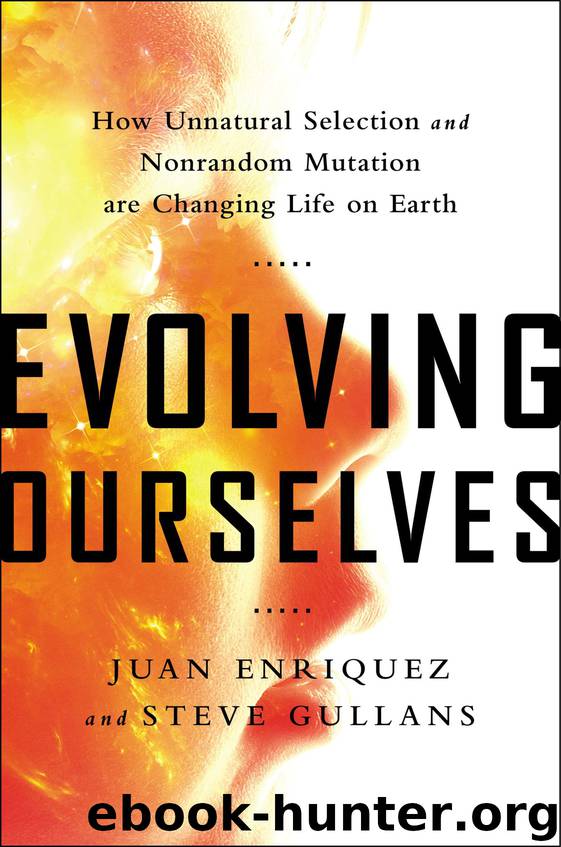Evolving Ourselves by Juan Enriquez

Author:Juan Enriquez
Language: eng
Format: epub
Publisher: Penguin Group, USA
Published: 2015-02-03T16:00:00+00:00
Humanity’s Really Short Story
Before we consider where we are going, let’s stop and consider how we got here. About 14 billion years ago, a single minute point of unimaginably concentrated energy fluttered, and caused the greatest explosion we can conceive of, ever. As plasma spread and began to form enormous clouds of dust, a few clumps of dust reached critical mass and gradually gravity took over.1 Immense quantities of dust began to compress until atoms began to fuse, which in turn ignited thermonuclear reactions, giving birth to stars.2 Trillions of new stars formed galaxies in wondrous shapes and sizes.3
We live in the Milky Way, a relatively ancient galaxy; some of its stars are almost as old as the universe (more than 13 billion years old).4 Within our galaxy lie 200 to 400 billion stars. (A mere uncertainty level of +/-200 billion stars, just within our own galaxy, gives you a small sense of how very ignorant we still are about the numbers.) Astronomers currently estimate there are 80 billion galaxies containing 30 to 70 sextillion stars.
Within the billions of planets and moons in our galaxy lies our sun, a teenager at a mere 4.57 billion years old. Leftover floating chunks of matter from the great explosion formed a few planets. Including a tiny planet called Earth, 4.4 billion years ago. That’s right: For more than two-thirds of the universe’s history there was no Earth.
Relatively soon after Earth was created, it was crawling with life.5 Then almost all life went through at least five major cycles of extinction. The Permian-Triassic cycle alone eliminated about 83 percent of all genera on Earth.6 (Talk about extreme spring cleaning!) It was only after the last major extinction, the Cretaceous-Tertiary about 6 million years ago, that mammals, and then humanoids, gradually and tentatively began to spread.
Put this all in context: 99.96 percent of the entire history of the universe took place before the first hominins, never mind the first humans, showed up. Then, after the rise and fall of at least twenty-five proto-humanoids, we, Homo sapiens, somehow escaped almost certain extinction, survived, and thrived.
Within this overall picture, do you really believe that we, the self-named Homo sapiens, are the be-all and end-all of the entirety of evolution? In other words, do you think the entire reason and purpose of the past 14 billion years of the known universe . . . and the sole purpose of 4.5 billion years of Earth’s history . . . and the sole purpose of 4 billion years of life’s evolution . . . and at least five cycles of extinction . . . was to create the likes of us?
Our story, our purpose of being, continues to unravel and evolve. When Darwin was around, the only humanlike fossils available for study were a few lonely Neanderthals. Now we know we branched off from chimps and bonobos about 6 million years ago, and eventually evolved into Ardipithecus ramidus about 4.4 million years ago. By 2009 we had more than 110 specimens detailing a few aspects of A.
Download
This site does not store any files on its server. We only index and link to content provided by other sites. Please contact the content providers to delete copyright contents if any and email us, we'll remove relevant links or contents immediately.
Sapiens: A Brief History of Humankind by Yuval Noah Harari(14319)
Sapiens by Yuval Noah Harari(5322)
Pale Blue Dot by Carl Sagan(4953)
Homo Deus: A Brief History of Tomorrow by Yuval Noah Harari(4871)
Livewired by David Eagleman(3729)
Origin Story: A Big History of Everything by David Christian(3666)
Brief Answers to the Big Questions by Stephen Hawking(3393)
Inferior by Angela Saini(3293)
Origin Story by David Christian(3170)
Signature in the Cell: DNA and the Evidence for Intelligent Design by Stephen C. Meyer(3098)
The Gene: An Intimate History by Siddhartha Mukherjee(3074)
The Evolution of Beauty by Richard O. Prum(2963)
Aliens by Jim Al-Khalili(2803)
How The Mind Works by Steven Pinker(2776)
A Short History of Nearly Everything by Bryson Bill(2659)
Sex at Dawn: The Prehistoric Origins of Modern Sexuality by Ryan Christopher(2500)
From Bacteria to Bach and Back by Daniel C. Dennett(2462)
Endless Forms Most Beautiful by Sean B. Carroll(2442)
Who We Are and How We Got Here by David Reich(2417)
